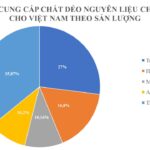Vietnam’s e-commerce continues to thrive, as evident in Metric’s Q1 2025 market overview report and Q2 2025 forecast. The sector witnessed an impressive growth rate, with total revenue reaching VND 101.4 trillion in the first quarter, up by 42.29% compared to the same period last year.
However, this growth is attributed to the concentrated buying power during the Tet holiday in Q1. For Q2 2025 (April to June), the market is expected to grow by approximately 21% compared to Q1. From now until 2026, Vietnam’s e-commerce growth rate is predicted to remain in the double digits, a positive sign.
Beneath this promising outlook lie worrying challenges. Mr. Do Huu Hung, CEO of Accesstrade, noted that while Vietnam is projected to become the second-largest e-commerce market in Southeast Asia by 2030 (after Indonesia), the growth rate is showing signs of slowing down. From 35-50% annually in previous years, the figure has now dropped to around 21%.
THE RISING DIVIDE IN E-COMMERCE: BIG BUSINESSES THRIVE, SMEs STRUGGLE
Notably, the Vietnamese e-commerce market is witnessing a growing divide. Global corporations like Unilever and Samsung are dominating market share on platforms such as Shopee Mall and TikTok Mall, achieving impressive growth due to their quality products, strong brands, and abundant financial resources. Meanwhile, local small and medium-sized enterprises (SMEs) are facing limitations in capital and competitive advantages, resulting in a gradual reduction of their operational space.
According to Mr. Hung, statistics show that approximately 38,000 small shops had no orders in 2025. While this number is not surprising as a similar situation occurs annually, the concerning aspect is the significant drop in the total number of shops with orders, from around 700,000 in previous years to 626,000 recently.
In previous years, when about 40,000 shops had no orders or left the platform, the market would welcome an additional 50,000–60,000 new shops to compensate. But presently, while small shops with no orders leave the market, the influx of new shops is slowing down. This indicates that SMEs are struggling to maintain their presence on e-commerce platforms due to the high operating costs, creating a significant barrier.
In contrast, enterprises with revenues above VND 10,000 billion are experiencing robust growth, with their scale of revenue continuing to expand. This reflects that businesses with quality products, strong brands, and abundant financial resources will perform more effectively on these platforms. The reality is that while increased operating fees on e-commerce platforms pose a significant challenge for SMEs, larger enterprises are willing to endure and even increase their investment budgets to solidify their position.
CHALLENGES OF COSTS AND RELIANCE ON FOREIGN PLATFORMS
According to Mr. Hung, a more serious issue is Vietnam’s gradual loss of control over its primary e-commerce distribution channels. The two largest e-commerce platforms are not owned by Vietnamese enterprises, and even direct distribution systems like BigC are now in foreign hands. This situation raises an urgent question: How can Vietnamese businesses regain control over product distribution and consumption in the domestic market and expand internationally?
“Our concern is how to bring e-commerce back to Vietnam, so that Vietnamese businesses can proactively distribute and consume products in the domestic market and expand internationally effectively,” said Mr. Do Huu Hung. “In our research, we found that China has not just 4-5 large platforms like Taobao, JD, and Tmall, or recently Temu, as we often think, but in fact, they have 250–300 different e-commerce platforms.”

According to experts, the development of e-commerce will go through three phases. In the first phase, there will be an explosion of large e-commerce platforms. During this stage, these platforms play a crucial role in educating the market – forming online consumption habits among users – and training sellers on how to approach customers and optimize operations.
In the second phase, as these platforms develop to a certain extent, the high operating costs will lead to increased service fees, making it challenging for many small businesses to maintain their presence on these platforms.
At this point, businesses realize the necessity of developing more independent and specialized distribution channels, such as building their own websites or creating e-commerce platforms tailored to their market and products. The success stories of Long Chau Pharmacy and The Gioi Di Dong are prime examples. Nowadays, when people need to purchase medicine or healthcare products, Long Chau’s online system often comes to mind.
The third phase is the trend towards e-commerce autonomy, where businesses not only sell on platforms but also become platform operators, developing their own ecosystems and leveraging technology to gain a competitive edge.
THE WAY FORWARD FOR VIETNAMESE SMEs IN E-COMMERCE
“The current challenge for Vietnam is not just about participating in the global e-commerce game, but also about learning to shift the model – from relying on foreign platforms to developing stronger domestic infrastructure and platforms, enabling Vietnamese businesses to sell not only domestically but also globally in a proactive and sustainable manner,” said Mr. Do Huu Hung.
Of course, platforms like Shopee and TikTok Shop remain essential and play a positive role in helping businesses reach customers and sell effectively. However, Mr. Hung believes that we need a more diverse and balanced development strategy to provide Vietnamese businesses – especially SMEs – with a wider range of options, allowing them to choose the right tools and channels that align with their products and target markets.
A strategic direction is to develop the e-commerce websites of the enterprises themselves. This is an important and prioritized direction because, by owning their websites, enterprises can proactively operate, control customer data, and sell across borders – effectively expanding their global reach instead of being wholly dependent on intermediary platforms.
However, developing domestic e-commerce platforms – especially building comprehensive “floors” unique to Vietnam – is a challenging task with many obstacles, including technological infrastructure, operational resources, consumer trust, and enterprise readiness.
Shinhan Bank: Empowering SMEs with Comprehensive Financial Solutions
“Shinhan Bank is committed to empowering small and medium-sized enterprises (SMEs) and micro-businesses with comprehensive financial solutions. Our goal is to provide a robust financial foundation for the sustainable growth of businesses, offering a wide range of tailored services to meet their unique needs and help them thrive in a competitive market.”
Unleashing Financial and Digital Solutions for SMEs: VIB’s Revolutionary Approach
International Bank (VIB), in collaboration with its partners Visa and Vietnam Payment Solutions Joint Stock Company (VNPAY), is proud to unveil a comprehensive financial and digitization solution designed specifically to empower Vietnamese small and medium-sized enterprises (SMEs) to enhance their governance, optimize their operations, and drive sustainable growth.





















